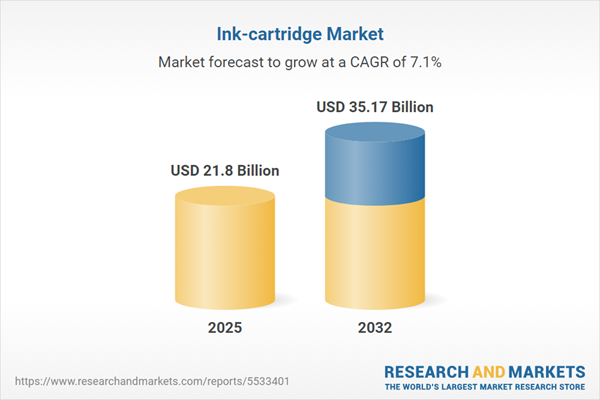Speak directly to the analyst to clarify any post sales queries you may have.
Senior decision-makers in the ink cartridge market must navigate evolving technology trends, heightened sustainability demands, and a complex regulatory environment. Effective leadership requires forward-thinking strategies that secure operations, support compliance, and position their organizations for continued success in a dynamic sector.
Market Snapshot: Ink Cartridge Market Size and Outlook
The ink cartridge market continues to display stable growth and resilience. Ongoing expansion stems from advances in digital printing solutions and increasing commitments to improved print infrastructure across sectors. Both commercial and residential markets drive demand for efficient and compliant printing options. Adaptable supply chains and strategic partnerships allow organizations to respond swiftly to market needs, maintain a competitive edge, and address new opportunities as end-user requirements shift.
Scope & Segmentation: Ink Cartridge Market
- Cartridge Types: Compatible cartridges present cost advantages for procurement teams. OEM cartridges ensure reliability critical for regulated industries, while remanufactured cartridges align with sustainability and circular economy initiatives—serving organizations focused on environmental targets.
- Ink Formulations: Dye-based inks are preferred by sectors prioritizing color vibrancy and visual impact, such as creative and office environments. Pigment-based inks deliver standardized durability for organizations emphasizing long-lasting documentation and archival needs.
- Cartridge Color Options: Black toner supports high-volume and standardized business printing, whereas color cartridges enable versatile brand communications and specialized workplace tasks.
- Cartridge Capacity: High-yield cartridges help minimize operational downtime and maintain steady output in demanding settings, while standard-yield cartridges suit daily, stable print requirements.
- Distribution Channels: Retail outlets, wholesalers, direct B2B procurement, and online platforms enable organizations to remain flexible and responsive during seasonal or unexpected demand changes.
- End Users: Commercial users depend on reliable performance over time, industrial customers require robust throughput, and remote or residential users seek easy integration and intuitive operation.
- Applications: Ink cartridges serve in packaging, labeling, document management, and media production, meeting professional and creative workflow needs in various environments.
- Regional Focus: Organizations face unique regulatory, cultural, and supply chain variables in areas such as the Americas, EMEA, and Asia-Pacific, influencing procurement and operational strategies.
- Leading Market Players: Organizations including HP Inc., Canon Inc., Seiko Epson Corporation, Brother Industries, Lexmark International, Samsung Electronics, Ricoh, Kyocera, Xerox, and Konica Minolta set industry standards with specialized portfolios tailored to a wide array of users.
Key Takeaways for Senior Decision-Makers
- Advanced digital print management tools support real-time status monitoring, helping executives streamline workflows and oversee distributed workforces cohesively.
- Choosing environmentally preferable cartridges, including remanufactured and refillable options, positions organizations to stay ahead of upcoming compliance trends and demonstrate sustainability leadership.
- Managed print subscription services simplify procurement, ensure operational continuity, and reduce administrative overhead through service-based solutions.
- Broadened supplier networks—combining digital sourcing, direct supplier relationships, and multiple channels—fortify supply chain resilience and responsiveness to evolving conditions.
- Ongoing investment in up-to-date print and ink technologies promotes adaptability, ongoing compliance, and safeguards confidential business information in shifting regulatory contexts.
Tariff Impact: Navigating U.S. Policy Developments
Recent changes to U.S. tariff rules have prompted organizations in the ink cartridge market to refine sourcing strategies. Nearshoring activities to Latin America and Southeast Asia offer pathways to cost controls and enhanced compliance. The expansion of local remanufacturing and refilling supports sustainability ethos and reinforces supply stability. Investing in automation and modular production methods further strengthens operational efficiency. Collaboration between buyers and suppliers remains vital for effective risk management and adaptive procurement as trade rules continue to evolve.
Methodology & Data Sources
This report draws on expert interviews, insights from industry leaders, validated trade publications, official regulatory documents, and extensive patent reviews. This approach ensures that findings are actionable and tailored for executive-level strategic planning in the ink cartridge market.
Why This Report Matters: Ink Cartridge Market
- Provides executive teams with evidence-based insights to drive procurement, sustainability, and digital transformation strategies as organizational needs progress.
- Prepares organizations to address regional regulatory complexities, enhancing agility and operational efficiency in global and local contexts.
- Enables the development of resilience strategies that keep organizations well-positioned amid ongoing industry changes and technological advancements.
Conclusion
Leadership that prioritizes digital innovation, supplier diversity, and sustainable business practices will enhance operational resilience and access opportunities as the ink cartridge sector evolves.
Additional Product Information:
- Purchase of this report includes 1 year online access with quarterly updates.
- This report can be updated on request. Please contact our Customer Experience team using the Ask a Question widget on our website.
Table of Contents
3. Executive Summary
4. Market Overview
7. Cumulative Impact of Artificial Intelligence 2025
Companies Mentioned
The companies profiled in this Ink-cartridge market report include:- HP Inc.
- Canon Inc.
- Seiko Epson Corporation
- Brother Industries, Ltd.
- Lexmark International, Inc.
- Samsung Electronics Co., Ltd.
- Ricoh Company, Ltd.
- Kyocera Corporation
- Xerox Holdings Corporation
- Konica Minolta, Inc.
Table Information
| Report Attribute | Details |
|---|---|
| No. of Pages | 189 |
| Published | October 2025 |
| Forecast Period | 2025 - 2032 |
| Estimated Market Value ( USD | $ 21.8 Billion |
| Forecasted Market Value ( USD | $ 35.17 Billion |
| Compound Annual Growth Rate | 7.0% |
| Regions Covered | Global |
| No. of Companies Mentioned | 11 |









